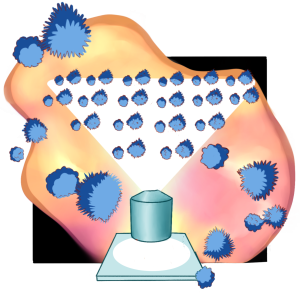UT researchers build molecule library to identify potential antibiotics
January 26, 2023
Using an advanced screening system, UT researchers compiled a library of peptide macrocycles, a type of therapeutic that may hold the key to combating antibiotic resistance.
Peptide macrocycles are large, circular molecules with the ability to reach more of their targets than smaller antibiotics due to their size, said lead author Justin Randall.
“Most of the newer clinical antibiotics — ones that could be used in the hospital to treat infections — now are macroscale and even macrocycles,” said Randall, a postdoctoral fellow in the Davies lab. “Because these macroscale (molecules) target things small molecules don’t, they often overcome traditional mechanisms of resistance to antibiotics that we already have.”
The study is built upon previous research that showed how molecules can form into a beta-hairpin structure that is specifically suitable for interacting with bacteria, co-author Bryan Davies said in an email.
“We were able to take that blueprint and form a really large library of macromolecules that are likely to form that beta-hairpin structure and cyclize, (so they can be that) cyclic structure rather than linear,” Randall said.
Bacteria were then engineered to produce peptide macrocycles as well as serve as a way to test their effectiveness.
“It works like a tether ball,” Davies said. “The peptide is bound to the surface of the test bacteria. The peptide can bounce around and come in contact with the bacterium. If the peptide is toxic, it kills the bacterium, and we can observe this event.”
Randall said the use of bacteria helped to narrow down the wide library of peptide macrocycles into molecules that could potentially serve as effective antibiotics. The research team took advantage of a machine learning algorithm to identify the 1,000 macromolecule sequences that could kill bacteria from a collection of 200,000. Ultimately, Randall said the team confirmed that 3 dozen had the capabilities.
Randall said that the lab is working on screening more molecules and designing new libraries based off of different macrocycle structures, which will help identify molecules with the potential for development into antibiotic treatments. The screening process is being implemented in multidrug resistant bacteria so the peptide macrocycles receive testing against actual pathogens.
Additionally, the data will be further analyzed to ensure that the treatments are strictly antibiotic and non-toxic to humans.
“It is a balance between finding something that can kill a bacterium but not hurt a human,” Davies said. “A hard balance to strike.”
Randall said that although this study didn’t identify peptide macrocycles that were strong enough to be used clinically, it continues to gather more data through screenings that will allow researchers to make better predictions as to which molecules could serve as effective therapeutics.
“Hopefully that puts us in a place where we’re discovering, fairly rapidly, new antibiotics to treat these multidrug resistant infections,” Randall said. “Then keep up with resistance as it continues to get gained to new antibiotics, which is really a very troubling thing in our future.”
















